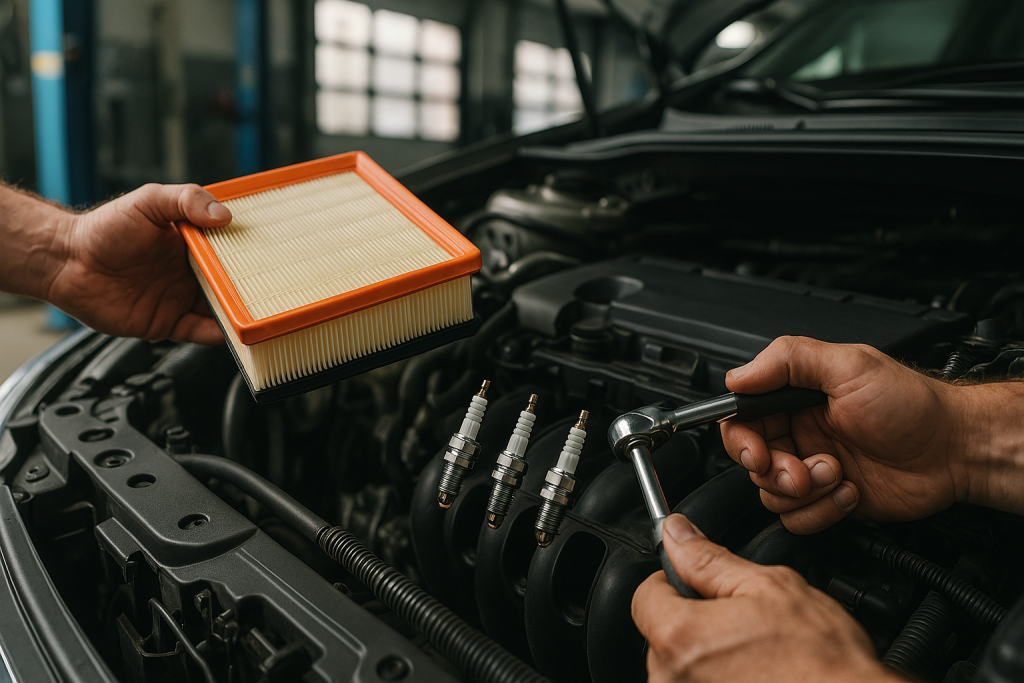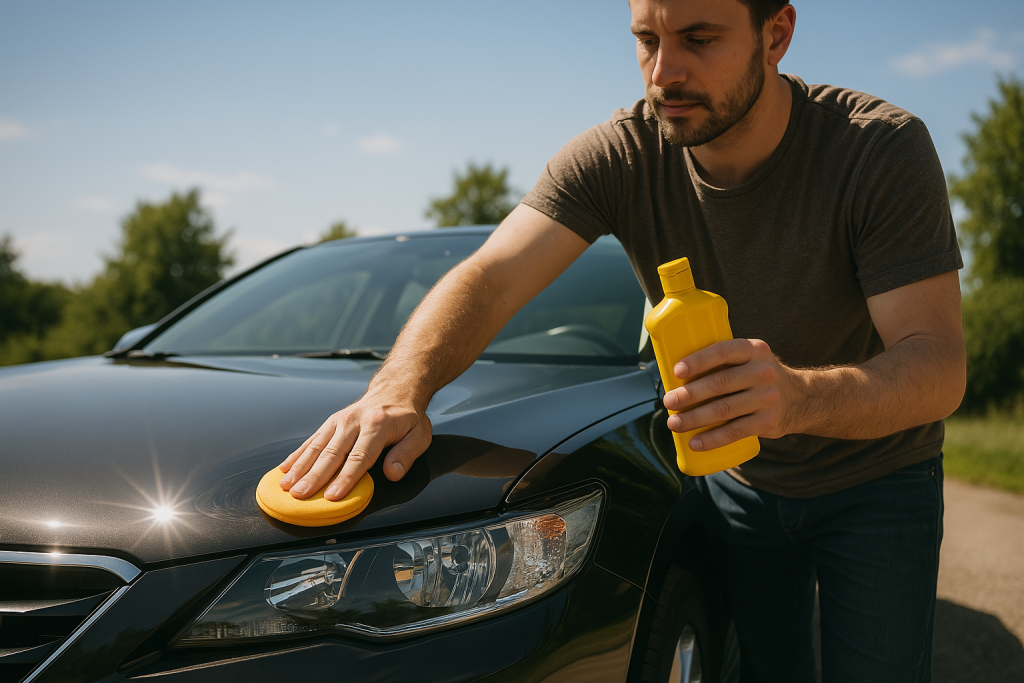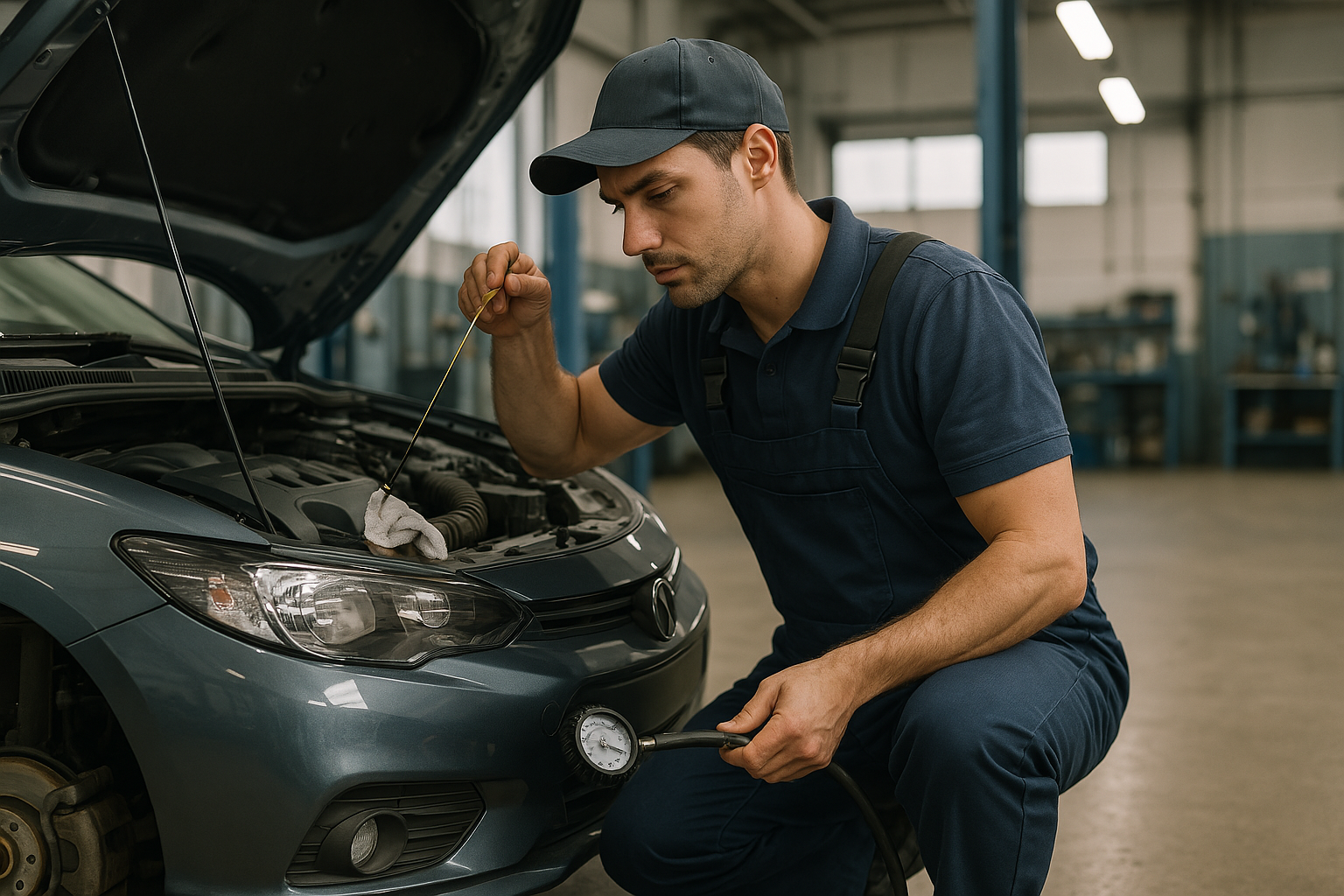Owning a car comes with a lot of responsibilities, and one of the most crucial tasks is keeping your vehicle in optimal condition. Regular automotive maintenance not only improves your car’s performance but also ensures your safety, reduces the risk of costly repairs, and extends the lifespan of your vehicle. In this blog, we will provide essential maintenance tips that every car owner should know to keep their vehicle running smoothly.
Table of contents
- Why Regular Car Maintenance is Crucial
- Top 10 Essential Automotive Maintenance Tips
- When to Seek Professional Help
- Seasonal Maintenance Tips
- Conclusion
- Frequently Asked Questions About Automotive Maintenance
- 1. How often should I change my engine oil?
- 2. How can I tell if my brake pads need replacing?
- 3. Why is it important to check my tire pressure?
- 4. How do I know if my battery needs replacing?
- 5. How often should I replace my air filter?
- 6. What is the purpose of changing spark plugs?
- 7. How do I maintain my car during winter?
- 8. Can I maintain my car myself, or should I always visit a mechanic?
- 9. How do I know when to replace my tires?
- 10. Why should I clean and wax my car regularly?
Why Regular Car Maintenance is Crucial
Importance of Preventative Maintenance
Preventative maintenance is key to avoiding major breakdowns and expensive repairs. Small issues can escalate quickly if not addressed promptly. For example, neglecting a small oil leak or ignoring a brake pad warning light can lead to engine damage or even accidents. Regular maintenance helps identify and fix these issues before they become more serious.
Maximizing Car Lifespan
Taking care of your car ensures it will serve you for many years to come. Properly maintained vehicles tend to last longer, run more efficiently, and retain their value better than those that are neglected. If you’re investing in a vehicle, it’s important to protect that investment through routine care.
Improved Safety
Your car’s safety features, such as brakes, tires, and engine performance, are directly impacted by how well you maintain it. Regular checks of these crucial components can prevent accidents and ensure that you and your passengers are safe on the road.

Top 10 Essential Automotive Maintenance Tips
- Check and Change Engine Oil Regularly
Engine oil is the lifeblood of your vehicle, and keeping it fresh is essential for maintaining engine performance. Over time, oil breaks down and loses its effectiveness. Check your oil regularly and follow the manufacturer’s recommendations for oil change intervals (usually every 3,000 to 7,000 miles, depending on the type of oil). Clean oil reduces friction in the engine and helps maintain fuel efficiency.
- Monitor Tire Pressure and Tread Depth
Tires are one of the most important components for road safety. Underinflated or worn-out tires can cause poor fuel efficiency, increased tire wear, and even blowouts. Check tire pressure monthly and adjust it as needed. Also, inspect the tread depth—replace tires that are worn down to ensure optimal grip and handling.
- Replace Air Filters
Air filters keep dirt and debris from entering the engine and ensure that it receives enough clean air for combustion. Over time, air filters can get clogged, reducing fuel efficiency and engine performance. Check your air filters every 12,000 to 15,000 miles and replace them if they’re dirty or damaged.
- Inspect and Replace Brake Pads
Brakes are essential for your safety, and regular inspection is vital. Brake pads wear down with use, and worn pads can lead to reduced braking performance. If you hear squeaking or grinding noises when you apply the brakes, it’s time to have them checked. Replace brake pads as needed to ensure you have reliable stopping power.
- Replace Spark Plugs
Spark plugs ignite the air-fuel mixture in the engine, and if they’re worn or dirty, they can cause poor engine performance, misfires, and reduced fuel efficiency. Check your spark plugs every 30,000 miles or according to your vehicle’s manual, and replace them if necessary to keep your engine running smoothly.
- Check Battery Health
A dead battery is one of the most common causes of unexpected breakdowns. Regularly check your battery terminals for corrosion and ensure it holds a charge. If your car is struggling to start or the lights are dimming, it might be time to replace the battery. Most car batteries last between 3 to 5 years.
- Replace Wiper Blades and Maintain Fluid Levels
Visibility is essential for safe driving, and good-quality wiper blades help keep your windshield clear. Replace wiper blades at least once a year or sooner if they leave streaks or don’t make proper contact with the glass. Also, check windshield wiper fluid levels regularly, especially before long trips.
- Inspect Belts and Hoses
Belts and hoses are critical for your vehicle’s engine performance, cooling system, and power steering. Look for cracks, fraying, or leaks in the belts and hoses. Replacing them before they fail can save you from breakdowns and expensive repairs. Have these checked during your routine maintenance to ensure everything is in good condition.
- Check Coolant Levels and Radiator Health
The cooling system keeps your engine from overheating, and it’s essential to monitor coolant levels. Low coolant can cause your engine to overheat, potentially leading to permanent damage. Make sure to top off coolant levels as needed, and inspect the radiator for any signs of leaks or corrosion.
- Keep Your Car Clean
A clean car is not just about aesthetics—it helps protect the paint and maintain the overall condition of your vehicle. Regular washing removes dirt and debris that can cause rusting or paint damage. Waxing your car once every few months adds an extra layer of protection. Inside, keep your car’s upholstery clean to avoid wear and tear and maintain comfort.
When to Seek Professional Help
Signs Your Car Needs a Mechanic
While many maintenance tasks can be done at home, there are times when you need to visit a professional mechanic. Pay attention to warning signs such as unusual sounds (clunking, grinding), strange smells (burning rubber or rotten eggs), or dashboard warning lights (check engine, oil pressure). If you notice any of these, it’s best to have a mechanic inspect your car.
Finding a Reliable Mechanic
When choosing a mechanic, ensure they are certified and have a good reputation. Ask for recommendations from friends or family, and check online reviews. Having a trusted professional on hand can make routine inspections and repairs much easier.

Seasonal Maintenance Tips
As the seasons change, so do the demands on your vehicle. Whether it’s preparing for the harsh cold of winter or the intense heat of summer, it’s crucial to perform maintenance to ensure your car is in top condition year-round. Here’s a detailed look at what you need to do to prepare your car for both winter and summer:
Preparing for Winter
Winter can be extremely tough on your vehicle, with cold temperatures, snow, ice, and road salt all contributing to wear and tear. To ensure your car runs smoothly and safely during the colder months, follow these winter maintenance tips:
- Check the Battery
- Cold temperatures can significantly reduce the performance of your car battery. If your battery is older or showing signs of wear (such as slow starts or dimming lights), it’s a good idea to replace it before the weather turns colder. Make sure the battery terminals are clean and free from corrosion to maintain a solid connection.
- Inspect and Replace Tires
- Winter weather often brings slippery roads, making it essential to have tires that can handle the conditions. If you live in an area that experiences heavy snowfall or ice, consider switching to winter tires, which are specifically designed to provide better traction in cold, snowy, and icy conditions. Check tire pressure regularly, as it can drop with colder temperatures, and ensure your tires have adequate tread depth to avoid slipping.
- Check Coolant and Antifreeze Levels
- Proper coolant levels are vital in winter to prevent your engine from freezing. Ensure that your antifreeze mixture is properly balanced (usually a 50/50 mix of antifreeze and water). Low or improper antifreeze levels can cause your engine to overheat or freeze, resulting in costly repairs.
- Inspect Wipers and Washer Fluid
- Winter weather often brings snow, sleet, and rain, so ensure your wiper blades are in good condition to provide clear visibility. If they leave streaks or are worn out, replace them before the cold weather hits. Also, check the windshield washer fluid to ensure it’s full and contains a formula designed to work in freezing temperatures, preventing the fluid from freezing in the reservoir.
- Prepare Your Exhaust System
- Snow and ice can sometimes block your exhaust system, which could lead to dangerous carbon monoxide buildup inside the vehicle. Ensure the exhaust system is free from blockages and check for any leaks before winter sets in.
- Prepare for Emergency Situations
- It’s always wise to have an emergency kit in your car during the winter months. Pack items like a blanket, flashlight, non-perishable food, extra gloves, water, and a first aid kit. Additionally, keep a small shovel, some sand or kitty litter for traction, and jumper cables in case your car gets stuck or your battery dies in the cold.
Preparing for Summer
Summer brings its own set of challenges for your vehicle, particularly with high temperatures and increased stress on certain components. Here are some tips to help keep your car running smoothly in the heat:
- Check the Cooling System
- Overheating is a major concern during hot summer months. Your vehicle’s cooling system, including the radiator, hoses, and coolant, must be in excellent condition to prevent engine failure. Ensure that your radiator is free from leaks and debris, and that coolant levels are sufficient. It’s also a good idea to flush the radiator every two years to maintain optimal performance.
- Inspect and Recharge Air Conditioning
- Summer heat can make driving unbearable without a functioning air conditioning system. Have your A/C system checked to ensure it’s blowing cold air and is free from leaks. If you notice a decrease in air flow or unusual noises, have it inspected by a professional. Regularly checking the A/C system in the spring or early summer will keep you cool throughout the hot months.
- Monitor Tire Pressure and Tread
- Hot weather can put extra strain on your tires, as the heat causes the air inside to expand. This can lead to overinflation, which affects handling, fuel efficiency, and increases the risk of a blowout. Make sure to check tire pressure regularly, especially before long trips. Summer also increases the likelihood of tires becoming worn out faster, so ensure your tires have enough tread to handle the roads safely.
- Inspect Belts and Hoses
- The high temperatures in summer can cause belts and hoses to wear out faster. These components are essential for engine cooling, power steering, and the air conditioning system. Check for cracks, leaks, or signs of wear, and replace any damaged belts or hoses to avoid breakdowns in hot weather.
- Keep Your Fuel System Clean
- Hot weather can also affect your vehicle’s fuel system. Contaminants in your fuel lines can cause poor performance and fuel efficiency. Consider having your fuel system cleaned to ensure smooth engine performance, especially if you plan on taking long road trips in the summer.
- Protect Your Car’s Exterior
- Summer sun can cause the paint on your vehicle to fade and crack. To protect the exterior, wash your car regularly to remove dirt, road salt, and debris, and apply a good quality wax to help protect the paint from UV damage. This also prevents rusting and helps maintain the car’s value.
- Check Your Windshield Wipers
- Summer storms can come out of nowhere, and your windshield wipers are essential for maintaining visibility. Ensure that the wiper blades are in good condition and replace them if necessary. Also, check the windshield washer fluid, as you’ll need it to clear off any dirt, bugs, or debris that accumulates during long summer drives.
Conclusion
Automotive maintenance doesn’t have to be overwhelming, but it does require regular attention to keep your vehicle in top shape. By following these maintenance tips, you’ll improve your car’s performance, extend its lifespan, and most importantly, ensure your safety on the road. Don’t wait until a major issue arises—be proactive and take care of your car today!
Stay ahead of car troubles with regular maintenance. Book your next service today and ensure your vehicle is ready for whatever the road throws at you!
Frequently Asked Questions About Automotive Maintenance
1. How often should I change my engine oil?
It’s generally recommended to change your engine oil every 3,000 to 7,000 miles, depending on your vehicle and the type of oil used. Always refer to your car’s owner’s manual for specific recommendations.
2. How can I tell if my brake pads need replacing?
If you hear squeaking or grinding sounds when applying the brakes, or if your car pulls to one side when braking, it’s time to have your brake pads inspected. In some cases, you might also feel vibrations or reduced braking power.
3. Why is it important to check my tire pressure?
Proper tire pressure is essential for safe driving and fuel efficiency. Under-inflated tires can cause uneven wear, decrease gas mileage, and increase the risk of blowouts. Check tire pressure at least once a month, or before long trips.
4. How do I know if my battery needs replacing?
Signs that your car battery might need replacing include difficulty starting the engine, dim headlights, or a warning light on the dashboard. Car batteries typically last 3-5 years, so it’s a good idea to have them checked regularly.
5. How often should I replace my air filter?
Air filters should generally be replaced every 12,000 to 15,000 miles. However, if you drive in dusty conditions or your filter appears dirty or clogged, it may need to be replaced sooner.
6. What is the purpose of changing spark plugs?
Spark plugs ignite the air-fuel mixture in the engine. Over time, they can wear out and affect engine performance, causing misfires, poor fuel efficiency, and difficulty starting the car. Spark plugs typically need to be replaced every 30,000 to 50,000 miles.
7. How do I maintain my car during winter?
Before winter, make sure your car’s battery, tire pressure, and antifreeze levels are adequate. You may also want to switch to winter tires for better traction on snowy or icy roads. Regularly check your vehicle’s radiator and make sure the heater and defroster are working properly.
8. Can I maintain my car myself, or should I always visit a mechanic?
While many routine maintenance tasks, such as checking tire pressure, changing oil, and replacing wiper blades, can be done by car owners, it’s important to visit a professional mechanic for more complex issues or if you’re unsure about any aspect of maintenance. A mechanic can also provide in-depth inspections.
9. How do I know when to replace my tires?
Tires should be replaced when the tread depth is less than 2/32 of an inch, which is the legal minimum in many areas. You can check tread depth with a penny—if you insert it into the tread and can see the top of Abraham Lincoln’s head, it’s time for new tires.
10. Why should I clean and wax my car regularly?
Cleaning and waxing your car regularly protects the paint from dirt, road salt, and UV damage, which can lead to rust and fading. A clean car also helps maintain its resale value and keeps the interior in good condition.




18 thoughts on “Automotive Maintenance Tips Every Car Owner Should Know”
ekgr0c
gfrpzj
owc6f7
ud6erw
7bb08j
v3x2r0
nk2goi
a4xta0
0wctt6
i7c7rf
8kgxh3
esglxx
jbzrg3
eg18yl
d1io53
fg1amv
rcmr9e
3qgd7q